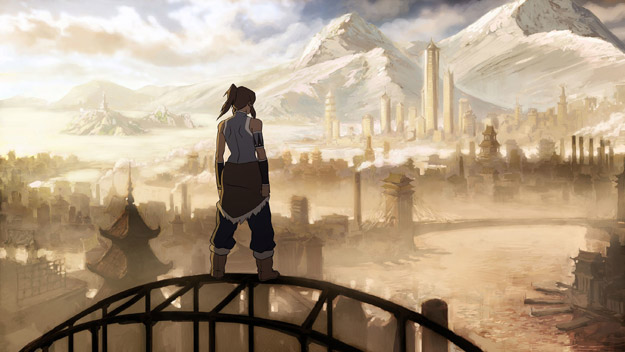The bad taste left in our mouths by the terrible Avatar: The Last Airbender film has been wiped out by the promise of a delicious new series!

The immediate reaction, if you’re me (and I see no reason to assume you’re not), is to seek out every possible piece of information, rumour and speculation about this. And basically every aspect of this fills me with joy.
The Legend of Korra starts 70 years after the defeat of Fire Lord Ozai. We have a new Avatar, Korra, the next after Aang a Southern Water Tribe woman. She’s older than Aang was, a teenage, and has already mastered Water, Earth and Fire. She’s come to Republic City to learn Airbending from Aang’s son Tenzin (Aang is presumed dead, unless they’ve pulled a Buffy). There’s people of all nations* in Republic City, it’s crime-ridden, and there’s an anti-bender revolt which Korra has to work against while learning to airbend. This will apparently be a slightly more grown-up series.
If you didn’t see Avatar: The Last Airbender and want to know what was so great about it, Shaker Seraph’s series of critical posts does a great job of exploring the show’s highlights and problems from a feminist point of view. For those of us who loved the series, a lot of the good feelings we had from a series with capable women everywhere, entirely populated by Asian*** characters, with a level of drama and storytelling not neared by your average childrens’ cartoon, that actually used the word ‘sexist’ were soured by a live-action film with none of these virtues. The good people at Racebending did more than anyone to push back against everything that was wrong with the film. I’d like to think that it’s partly because of them that Nickelodeon commissioned a new series with all the things we loved about the old one. It’s probably just because the movie made some money, but still.
And the lead character’s a woman! But then, why wouldn’t she be?
The new ‘Avatar’ is a woman. What inspired you to change the sex of the protagonist of the series?
Michael DiMartino: It’s not so much about changing because we had Avatar Kyoshi before Aang. We’d established that the Avatar can be male or female and we just thought let’s explore one of those more in depth, because Kyoshi was a popular character with a lot of fans and it seemed like a great opportunity to not retread what we’d done with Aang, who was a great hero, we all loved him, but we really wanted to try something different. And we have so many great female fans out there, who really responded to Katara in the first series, we thought we have the fan base who are really going to enjoy seeing the Avatar be a female.
Konietzko: Mike and I, we love those characters too, and we’ve encountered countless fans who are male who really like those characters too. We just don’t subscribe to the conventional wisdom that you can’t have an action series led by a female character. It’s kinda nonsense to us.
More of this, please.
*In Buffy the Vampire Slayer, when the current Slayer dies a new young woman becomes the Slayer. In the finale of Season One, Buffy’s heart stops in a fight with the Master. Xander revives her, but her ‘death’ was enough to trigger the awakening of a new Slayer, Kendra. You’re welcome!
** ‘All nations’ is what this press release says. Does that mean the Air Nomads are back somehow? Perhaps some escaped the genocide!
*** At least, they’re as Asian as the characters of Lord of the Rings are white.
Endnote: we thought we’d pass on this announcement from Threadless, as some of our readers might be interested. We at GW are unaffiliated with Threadless and have no involvement with this promotion:
Threadless has recently launched their newest ‘loves’ competition entitled ‘Threadless Loves Comics’. Threadless is SUPER excited for this one, because the chosen design will actually be worn by a character in an upcoming issue of New York Times Bestseller, Chew! (which is now becoming a TV series)! And that’s not even the half of it! $2,000 in cash, a $500 Threadless Gift Certificate, Original art, an iPad, and a collection of graphic novels are up for grabs, too! All you need to do to enter is create a design that is inspired by comics. Entries are being accepted until August 12th.


